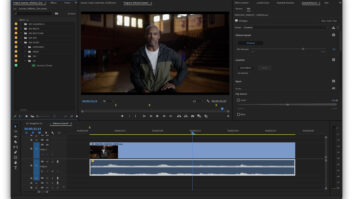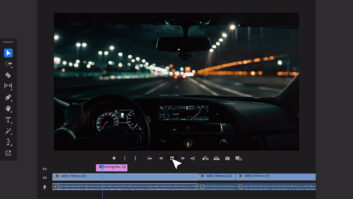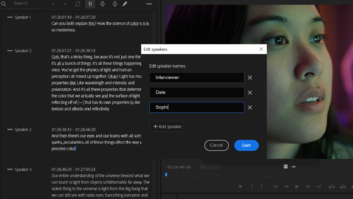NAB News: Adobe has launched version 5.5 of its powerful Creative Suite post-production package, including major updates to After Effects, and completely revamped its audio software, writes David Fox.
The complete package offers what Eric McCashey, its Group Marketing Manager, Desktop Solutions, claims is “the industry’s most efficient post-production workflow,” which is why it has been adopted by such broadcasters as the BBC, Turner and Hearst.
“It is rare to see a piece of media that has not been touched in some way by Adobe technology,” he said.
With CS5.5 Adobe ‘is attempting to stay ahead of trends in the industry,” and it is changing its release schedule to do that. In the past it has released new versions of Creative Suite every 18-24 months, but it is now moving to every two years, with bigger interim releases (such as 5.5). Its main rival, Apple is expected to announce a complete revamp of its Final Cut Studio suite on Tuesday night.
Although Adobe is committed to its Flash interactive and video format, it has recognised that users of its Creative Suite also have to deliver to devices, such as the iPad, that don’t support it, which is why CS5.5 will also support HTML5 authoring (including the easy addition of different video codecs), and will allow easier creation of rich, interactive applications for iOS, Android and Blackberry.
Indeed, Adobe is also making use of such devices to allow creatives to create ideas or interact with its desktop software, particularly Photoshop.
Audition piece
Adobe’s digital audio workstation software, Audition has returned to the Creative Suite, and is now on both Mac and Windows. It will replace Soundbooth.
Audition has been rebuilt and is “much faster and much more responsive,” claimed Niels Stevens, Business Development Manager, Video Products, who demonstrated how quick and easy it is to capture a noise print from a clip and reduce background noise from a dialogue track. “It’s a really, really fast workflow. Much faster than real time,” for export back to Premiere Pro.
It also gains a full surround sound mixer, and there is a new clip merge function, to re-synch the audio from an external recorder to video captured on a DSLR or digital cinema camera. The Merge Clips command can sync up to 16 audio clips to a single video clip.
After Effects features improvements for stereoscopic 3D users, including control over divergence and convergence of pairs of virtual cameras in 3D graphical models.
The new Warp Stabilizer requires no user intervention, being completely automatic. It was demonstrated taking shaky footage from a hand-held camera phone and making it look as if it was on a tripod (either with a slight pan or locked off), with the conversion happening in seconds with minimal loss of quality. Also new are Camera Lens Blur, to control which parts of a scene are in focus, and Light Falloff, to manage how light behaves in a 3D scene.
There is also full OMF, AAF and XML import and export in After Effects and Premiere, and Adobe has improved the Mercury 64-bit playback engine, which now supports a wider range of Nvidia CUDA (Compute Unified Device Architecture) graphics cards, with more effects running natively on CUDA. It has also enhanced its offerings for Red (with Redcine now supported), and added support for Canon’s XF format, including the ability to view spanned clips. In After Effects, users can now import CinemaDNG files and export XDCAM-EX footage.
Metadata created in Adobe Story, its online service for collaborative script writing, can be carried all the way through production, and using Premiere’s speech-to-text abilities, can be aligned with the video, so you can edit using the script. There is tight integration between the applications, allowing users to move projects easily between Premiere and other editing tools, and iterate quickly thanks to Dynamic Link between After Effects, Premiere, and Encore (for DVD and Blu-ray authoring).
The Media Encoder has been improved to make it easier to use, and to do renders in the background, taking advantage of multiple CPU cores. It supports a wide range of output formats, including FLV, F4V, Windows Media, QuickTime, and other popular codecs such as MPEG-2, MPEG-4, H.264, and (new for CS5.5) AVC-Intra and DPX.
For users creating video or web pages for mobile devices, an enhanced Design Central allows them to test any content on different devices, without having to own them, including how it looks when you rotate the device.
Adobe will also be introducing a new way of paying for the Creative Suite, using subscriptions, which should make it easier and cheaper to add temporary licences for freelancers and one-off projects.






